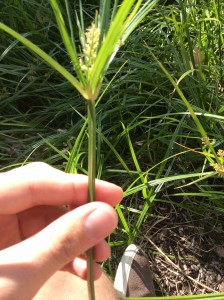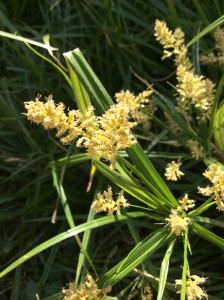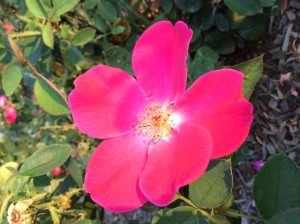A plant with whorled leaves — Eutrochium spp. Joe pye weed: Family Asteraceae. Found in Jenning’s courtyard.
A member of the Fabaceae with an explanation of the characters that you used to determine the classification.
Trifolium repens: White Clover; The central flower has the distinctly “boat” shape with a banner, two wings, and a keel. Additionally, the flowers are zygomorphic with one style and stigma. Found growing in the grass beside Aronoff Lab’s entrance.
Parthenocissus quinquefolia: Virginia Creeper. Found growing across from the veterinary hospital on the fence line bordering 315. Palmately compound leaf. 5 leaflets.
A member of the Cyperaceae with an explanation of the characters that you used to determine identification.
Unknown Sedge spp. “Sedges have edges”. The picture on the left demonstrates the triangular stem. The inflorescence also shows the flower subtended by a bract. Found outside in the planter area of the Jennings Loading Zone.
Rhamnus cathartica (common buckthorn). Black drupe fruit. “Wannabe” thorn at the terminus of the branch. Found off of 1315 Kinnear Road (The MBD) growing along the fence among honeysuckle.
A plant with pinnately compound leaves and stipules. Rosaceae cultivar. Found in planted circle beside the Ohio Stadium. Characters: stipules on Rosaceae petioles, compound leaves.









Hi. My name is Rachel Robinson and I’m a veterinary student from http://riversideveterinaryclinic.net. I am actually reading up on veterinarian scientific research and medicine subject matters for a crucial assignment associated with particular professional researches our team are undertaking at the center. I discovered several intriguing and useful information and facts browsing the materials in this web site therefore simply just intended to thank you. Carry on with the great work!
Your rosaceae flower also have many stamen! I also used a rose, multiflora rose, as an example of that characteristic. Roses do a great job of showing the characteristic of many stamen!
I wonder why some of the creeper leaves turn read before others? If all the leaves on one plant are connected by common vasculature and getting the same hormonal and light cues about season change, why do some senesce before others?
Great pictures and I liked the way you had something in the pictures to reference the size of the plant or plant part.
I used the Joe pye weed as my plant that produces achenes. The whorled leaves in groups of 4 helped me identify this plant in Newcomb’s.